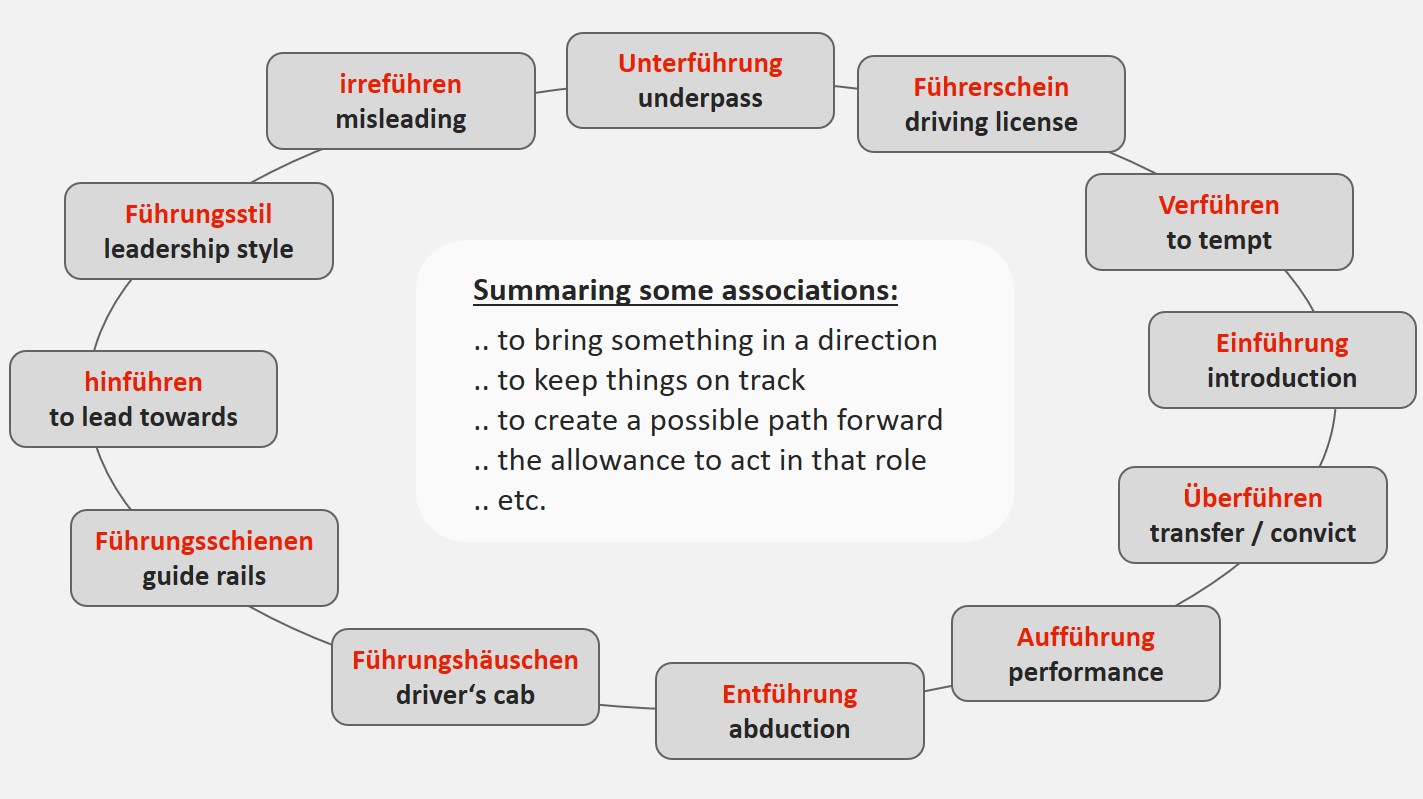On Leadership in Business
Leading as a service
Author: Dr. Margit Sarstedt
In a leadership position, leading should be perceived not as a right, but as a committment. In any case, it is work. In the leadership role, the leader provides a service to the employee, service for the objectives, and service in the interest of his own supervisor or client. Often these relations are forgotten or even equated with questions of power. It is therefore worthwhile to trace back on the concept and idea of leadership.
-----
Leadership and leading – a conceptual clarification
For an initial basic understanding of the terms leadership and leader, an etymological view of the words is interesting. The following (on the German word for leading: “führen”) is taken from the work of Gerhard Köbler: German Etymological Dictionary, 1995 [1].

So, when we lead, then "we make something move" and "we get things going". As old as the word origin and this meaning is, from my point of view even today we could hardly summarize it any better what the role of a leader should actually be. And the leader as "breadwinner" and "carrier" also seems to me quite fitting. Carrying the burden of leadership, this already indicates engagement in the service role mentioned above.
Leadership seminars – an exercise
In seminars for executives, I like to do a little exercise. Find words that contain the words 'leadership' or 'lead'. Below I share a small collection of the really large amounts of words that usually come together.
(To my readers: kindly note the language difference and shift in meaning between German and English. I decided to stick to the idea and keep the German original, merely giving the translation for ease of better understanding.)

Here again, leadership has something to do with bringing things in one direction, creating paths, and keeping the events on track.
Leadership in today’s definition
A look into Wikipedia is also worthwhile for a better understanding of today's definition. There, the German term "führen" (to lead) [2] is subdivided into (translated from German):
i. The act of steering and giving direction
ii. Giving directives or orders in the legal sense
iii. The Military power
iv. The start-up of a vehicle
v. Having a firearm ready at hand
Many misunderstandings on the issue of leadership in companies stem from the frequent association of the term with the third point (iii). In fact, this is neither custom nor appropriate in a company environment (although there are exceptions, take a fire-alarm situation for example). However, it is the first two points which in companies need to be considered regularly (i, ii).
It is a simple fact that giving directives in the legal sense (point ii.) takes place in companies and other organizations, and it is regulated both in employment contracts and in labor law. And this can indeed not be overruled by recent trends towards flat hierarchy, agile management, or the herein expressed view on leadership as a service. However, this article is not about these legal aspects.
Instead, let's move forward under the first point (i.).

Leadership as steering and giving direction
So let's have a look at the term "leading". In the category companies and organizations we find the relevant terms: team leadership (a manager influences a team within the scope of the operative management concept), and individual leadership (situational and goal oriented influencing of an employee by a supervisor) [3]. So, to put it in the words of the Gabler Wirtschaftslexikon, this implies an asymmetrical social relationship of over- and subordination [4], or in other words, a clear hierarchy.
Trend towards the elimination of leadership and hierarchies?
For some years now, there has been a strong trend to fundamentally question hierarchies and leadership concepts in the world of work. Thus, fashion trends have emerged which – presumably – eliminate the hierarchies and – again presumably – manage without any guidance. What can we make of that?
The simple words "flat hierarchy" [5] seem to exert a fascination on many people – on employees and on leaders alike, albeit probably for different reasons. For it is often erroneously assumed that in a flat hierarchy all parties involved are equal and contribute to the development according to their own ability and will. This image is downright celebrated, outwardly at least. In reality it often looks different, as is wonderfully portrayed in the article by Christoph Schäfer “Der Dienstwagen lebt” (The company car is alive) [6]. More on the topic of flat hierarchy will be covered in future articles within these contributions.
What are the reasons for rejecting leadership? Is that a generational question? Probably not only. But just recently a participant in a seminar told me that young employees just do not want to be led. So should we follow the trends and stop any kind of leadership altogether? I think not. Because the rejection of leadership, it seems to me, is in reality a rejection of misguided leadership.
Criticism on leadership and hierarchy
Let's take a closer look at some of the criticisms of hierarchies and leadership structures, together with an assessment of the individual points.
1) For many decades already, a leadership style that comes along with mechanistic work organization, directives and control, is rejected by the present-day generations.
o However, to cite this today as an argument against management structures is, in my opinion, anachronistic, because there is hardly any such management style anymore, at least in commercial companies.
2) Employees are also increasingly concerned with the question of whether the respective leaders understand the goals as a common cause.
 o This seems to me an important topic of our time. Not seldom the day-to-day worries of the management levels deviate strongly from the day-to-day worries of the employee levels. This leads to a pronounced distancing between the hierarchy levels, which by itself leads to a lack of communication between the hierarchy levels, and in turn to frustration and rejection.
o This seems to me an important topic of our time. Not seldom the day-to-day worries of the management levels deviate strongly from the day-to-day worries of the employee levels. This leads to a pronounced distancing between the hierarchy levels, which by itself leads to a lack of communication between the hierarchy levels, and in turn to frustration and rejection.
3) A leadership that disregards employees' needs for autonomy in their work is increasingly being denounced.
o People – rightfully – want to deploy what they have learned responsibly and on their own. But what exactly does responsibly mean? Delegating responsibility is good and necessary. However, it has its limits. On the one hand, the responsibility for results will always remain anchored in the management levels. On the other hand, it should also be necessary in the future to take the degree of maturity of the employees into account when transferring responsibility. A fine balancing of the interaction between the hierarchical levels (concerning actions and responsibilities) is necessary. Future contributions will deal further with this topic.
4) The insistence on traditional knowledge is not accepted by the next generations. This natural distribution of roles comes especially to light in today's world of global networks and digital media.
o However, the common sense born of experience should not be lost by the fast pace of time. This places high demands on the leaders, who need a clear view of the future as well as attention towards their employees. This requires openness, adaptability, and the linking of empirical values with newly emerging ideas. In one word, it requires agility in the management task.
The criticism of the reality in leadership structures exists therefore quite rightfully. However, it is not the existence of hierarchical levels and leadership structures that should be called into question, but the way in which leadership is exercised.
It makes no sense to spill the baby out with the bath. Because for the advancement of the work the threads must converge somewhere. Not everyone involved in the overall process can always keep track of everything. There must be a central coordination and, yes, decision point. Otherwise, division of labor makes little sense, at least on the large scale.
Does Agile Management constitute the solution?
So much is being said and written about Agile Management. However, if you look at contributions from different authors, you find that there is really no clear and consistent definition of agile management.
From the various aspects of what is understood by Agile Management, let's take a look at Agile Leadership. The range extends from a "leadership on demand" concept, in which the leadership is temporarily taken over ever again by new team members [7], right up to borrowing from the Transformational Leadership concept [8], and the reduction in importance of expert's knowledge in the leadership role [9]. Despite the variation in the views of the authors, both define by name the leadership function as a serving role, in combination with the self-organization within the team.
In my estimation, however, an ever more pronounced demand for self-organization within the teams, often combined with the focus of the remaining management levels on the company’s commercial perspectives [9], leads precisely to the fact that the gap between the individual hierarchical levels further increases. I am convinced that thus communication between the management levels can be interrupted or even eliminated.
But it is communications that is the key point of agile management to make the enterprise more flexible. This is nicely elaborated in a report by Svenja Hofert [10]. She addresses that agile management is all about a leadership and corporate culture that has to react flexibly to change. Most of the conclusions drawn from this with regard to agile leadership are, as she also points out, not new, but actually many decades old [10].
-----
I am therefore convinced that, overall, the concept of agile leadership needs some caution. After all, leadership is all about directional control, it is about bringing people and tasks together in a meaningful way, and it is about creating freedom in the leadership functions for the necessary foresight. Neither the elimination of hierarchies, nor an introduction of rotating leadership responsibility, nor a complete self-organization of teams can render these key elements of leadership.
This can rather only be achieved through a kind of employee-oriented approach, a culture of dialogue at eye level, and the courage to assume responsibility in the various hierarchical levels. All of this makes the leader a character who puts himself at the service of all to make meaningful work possible in the first place.
Leadership as service – my conclusions
- When we lead, we „make something move“, we get things going, steer in one direction, and keep on track.
- For every work organization, there must be nodal points, a linchpin of the flow of information. There you need personalities with vision and experience, because there – regularly or at least in case of doubt – the decisions have to be taken.
- Not the elimination of all hierarchies and management structures is the solution, but rather a good cooperation between the hierarchies.
- For the leadership task this requires a clear employee-oriented approach, a leadership at eye level, to consider the issues together with the employee, and to be able to let go at the right moment.
- It also requires a subtle control by the leader of what happens at the decision points. In this way, meaningfully defined hierarchical levels are not eliminated, but flattened out by topic.
- Leadership – rightly understood – is therefore not a right, not a privilege, but rather active work. And work, indeed, not only in the interest of the objectives, but above all it constitutes a service to the workforce.
References:
[1] Gerhard Köbler: Deutsches Etymologisches Wörterbuch, 1995; http://www.koeblergerhard.de/der/DERF.pdf.
[2] Wikipedia (Stand 21.07.2018): Führen; https://de.wikipedia.org/wiki/F%C3%BChren.
[3] Wikipedia (Stand 21.07.2018): Führung; https://de.wikipedia.org/wiki/F%C3%BChrung.
[4] Gabler Wirtschaftslexikon (Stand 21.07.2018): Führung; https://wirtschaftslexikon.gabler.de/definition/fuehrung-33168.
[5] Wikipedia (Stand 16.07.2018): Flache Hierarchie; https://de.wikipedia.org/wiki/Flache_Hierarchie.
[6] Christoph Schäfer: Der Dienstwagen lebt, Frankfurter Allgemeine (Online, Stand 18.07.2018); http://www.faz.net/aktuell/beruf-chance/beruf/statussymbole-im-job-der-dienstwagen-lebt-15442645-p2.html?printPagedArticle=true#pageIndex_1.
[7] Valentin Nowotny: Unternehmenskultur – Was ist eine agile Organisation?, business-wissen.de (Online, Stand 18.07.2018); https://www.business-wissen.de/artikel/unternehmenskultur-was-ist-eine-agile-organisation/.
[8] Wikipedia (Stand 20.07.2018): Transformationale Führung; https://de.wikipedia.org/wiki/Transformationale_F%C3%BChrung.
[9] Bernd Rutz: Agile Leadership: Was Agile Führung ausmacht, Haufe.de (Stand 20.07.2018);
https://www.haufe.de/personal/hr-management/fuehrungsmodelle-agil-fuehren-lernen_80_212704.html.
[10] Svenja Hofert: Agile Führung: Warum jetzt alle auf den Zug springen – und 6 Gründe, die Finger davon zu lassen, Informatik Aktuell (Online, Stand 20.07.2018);
